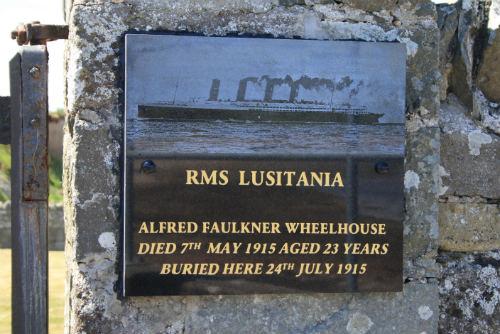RMS Lusitania - remembering Alfred Faulkner Wheelhouse
In May 2018, to mark the 103rd anniversary of the sinking of RMS Lusitania, Peter Kelly shared these details from a rather moving biography.

As the anniversary of the sinking of Lusitania approaches, I’d like to recount a story of a conspiracy! A conspiracy demonstrating the humanity, compassion, consideration, and decency of two men - one in Liverpool, and the other in the south west of Ireland – in an effort to ease the pain and heartache of the widowed mother of one of the crew members who perished in the sinking, and give her some inner peace by facilitating her visit to the final resting place of her dear son.
My story begins with the recovery of the remains of Junior Seventh Engineer Alfred Faulkner Wheelhouse at Kilmore, near Ballyduff, County Kerry, Ireland, on 24 July 1915. Having been immersed in the sea for more than eleven weeks, his remains were incomplete and in bad condition. Before being interred that same evening in nearby Kilmore burial ground, his personal effects were removed from him, and it was a silver matchbox with the name “A. Wheelhouse” inscribed on it that led to his identification. His property was delivered to his mother, Matilda, in Liverpool a few days later.
Within days of receiving the notification of the recovery and burial of her son’s remains in Ireland, Matilda Wheelhouse communicated a desire to the offices of the Cunard Steamship Co Ltd, to visit the final resting place of her dear son. This is where an unknown official from Cunard in Liverpool, and the Sergeant in charge of the Royal Irish Constabulary barracks at Ballyduff – Sergt. William Best - engaged in a conspiracy by post and telegram. Although it is likely that these men never met, or knew anything of one another, they decided that the details of the condition of Alfred’s remains should not be revealed to his mother. They also agreed to tell Matilda that local people attended the burial and that a number of local women cried over his coffin, as was traditional at Irish funerals at that time. In early August 1915, at Cunard’s expense, Matilda travelled by rail and sea to Ballyduff, where a horse and carriage awaited her arrival at the railway station. Sergt. Best escorted Matilda to her son’s grave and he promised to have wooden railings erected around the grave, at her request.

British First World War propaganda poster MMM.1997.23
When she returned to Liverpool, Matilda wrote a letter of gratitude to the Cunard official. In this letter she expressed the comfort she felt knowing where her son was buried, when others did not, and the contentment she felt having seen his grave for herself. She also expressed her appreciation for all Sergt. Best had done for her and her son. Despite the horror and tremendous loss of life resulting from the sinking of Lusitania, which obviously increased the workload on officials at Cunard and the Royal Irish Constabulary, it is heartening to know that there were caring, considerate, and compassionate people who took the time to ease the pain and heartache of the families and friends of those who had lost their lives, and conspired together to keep the horrific details from them.
The Ballyduff community arranged for a memorial plaque for Alfred Wheelhouse (pictured above) to be mounted on the wall of the cemetery in 2016. You can read the full biography of Alfred Faulkner Wheelhouse in the ‘People of the Lusitania’ resource in the ‘Lusitania: life, loss, legacy’ exhibition.

Lusitania commemoration Monday 7 May 2017
